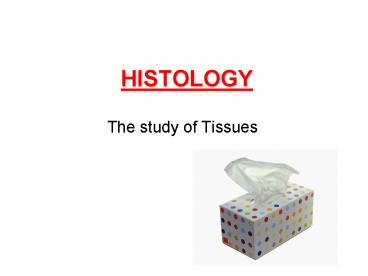HISTOLOGY - PowerPoint PPT Presentation
1 / 25
Title: HISTOLOGY
1
HISTOLOGY
- The study of Tissues
2
Overview of Tissues
- All the organs of the body are made up of four
basic tissues (1) Epithelial, (2) Connective
Tissue, (3) Muscle Tissue and (4) Nervous Tissue.
3
Epithelial Tissue
- Cells that line surfaces
- Epithelium is the name given to the cells that
line a surface (surface of the body- epidermis
surface of body cavity and internal organs inner
surface of ducts and tubes and glands (sweat,
salivary, etc.) are also formed by epithelial
cells.
4
Functions of Epithelial Tissue
- Form barriers - are always contiguous with one
another and are usually joined by special
junctions. (tight gaps, etc.) intercellular
space between epithelial cells is very limited. - Permeability some are much more impermeable
than others. The epidermis of the skin is an
impermeable barrier the epithelium lining the
intestine, while providing a barrier, must also
absorb nutrients. - Secretory Function- (eg. stomach, glands)
5
Terminology
- Free surface All epithelia have a free surface,
that is to say a surface to which no cellular or
extracellular formed elements adhere. The free
surface may contain specialized modifications,
such as microvilli (increase the absorptive
surface) or cilia (move secretions). - Basement Membrane All epithelia rest on a
basement membrane, through which it is attached
to the underlying tissue.
6
Types of Epithelial Tissue
- Epithelia are classified according to the number
of layers of cells they contain and the shape of
the cells. - Layers Shape of Cell
- Simple 1 layer Squamous flattened cells
- Stratified 2 or more layers Cuboidal same
height, width, depth - Columnar height exceeds their
width - Note if there are multiple layers and they dont
look similar you comment on the outermost layer
regarding the shape
7
Simple Squamous Epithelium
- Figure 1 shows the simple squamous epithelium
lining within the capsule of the kidney
8
Simple Squamous Epithelium
- Figure 2 shows the aorta lined by a layer of
flattened cells called endothelial cells (arrows).
9
Simple Cuboidal Epithelium
- Figure 4 shows parts of several thyroid gland
with cuboidal cells in a roughly circular
pattern.
10
Simple Cuboidal Epithelium
- Figure 5 shows parts of the kidney tubules
consisting of simple cuboidal epithelium.
11
Simple Columnar Epithelium
- Figure 6 shows the tall simple columnar
epithelium of the duodenum with bears a brush
border formed by microvilli which greatly
increase the absorptive surface.
12
Stratified Squamous Epithelium
- This type of epithelium is found on tissues
likely to encounter friction. - Figure 7 shows the stratified squamous
epithelium of the esophagus (the shape of the
cells can be inferred from the shape of the
nuclei and that they are identifiable in all
layers)
13
Stratified Squamous Epithelium
14
Stratified Squamous Epithelium
- Figure 8 shows another example of stratified
squamous epithelium of the epidermis of skin. The
cells can be seen to become more flattened toward
the deep-staining red layer. The deep stained
area are cells filled with keratin (protein)
through a process known as keratinization. More
specifically this epithelium is known as
keratinized stratified squamous cell epithelium
or cornified stratified squamous epithelium
associated with the soles and palms.
15
Stratified Squamous Epithelium
16
Stratified Squamous Epithelium
17
Stratified Cuboidal Epithelium
- Figure 9 demonstrates stratified cuboidal
epithelium associated with ducts of various
glands (sweat glands, sebaceous glands)
18
Stratified Columnar Epithelium
- Figure 10 Found associated with the largest
ducts of glands (submandibular).
19
- In addition to the above, there are two special
types of epithelium called Pseudostratified and
Transitional.
20
Pseudostratified Epithelium
- Figure 11 demonstrates Pseudostratified
epithelium which has the appearance of being
stratified, because it has cell nuclei at
different heights within the epithelium. This is
because it has some low cells which do not reach
the free surface, and some tall cells, which do.
However, all the cells rest on the basement
membrane, so it is in fact a simple epithelium.
In sections of pseudostratified epithelium, it is
quite often difficult to discern that all the
cells sit on the basement membrane. The
distribution of pseudostratified epithelium is
fairly limited. It is found in parts of the
respiratory and male reproductive systems.
21
Pseudostratified Epithelium
22
Transitional Epithelium
- Figure 12 shows Transitional epithelium found in
parts of the urinary system (kidney, ureter,
urinary bladder urethra) that can be distended by
the pressure of urine. The thickness of
transitional epithelium depends on the state of
distension (full) or contraction (empty). When
the ureter or bladder is empty, the epithelium
can be six or more layers deep, when it is
distended, the epithelium is only two or three
layers deep.
23
Transitional Epithelium
24
(No Transcript)
25
(No Transcript)

